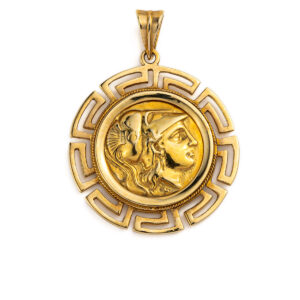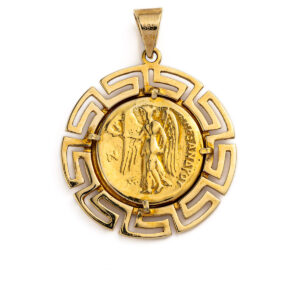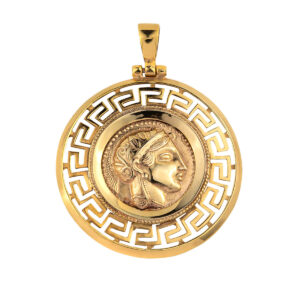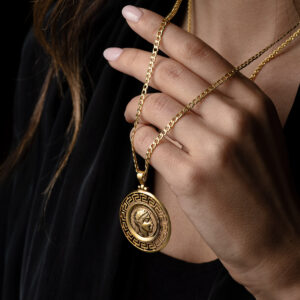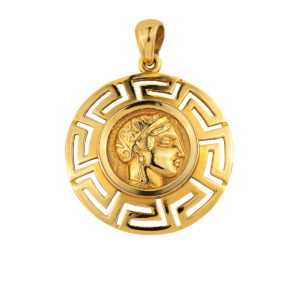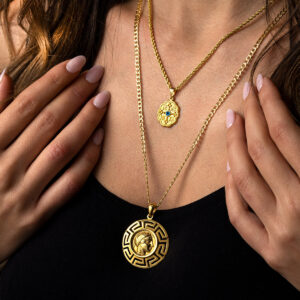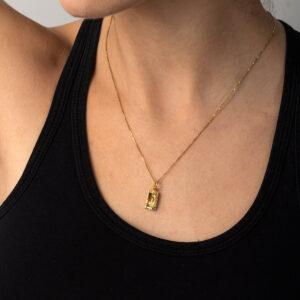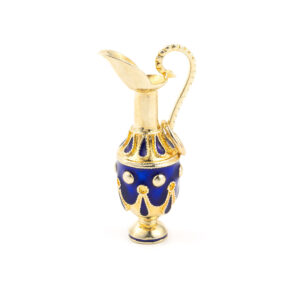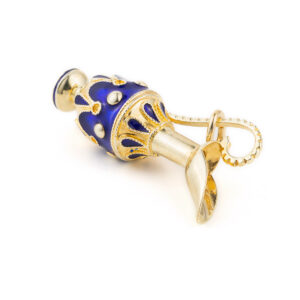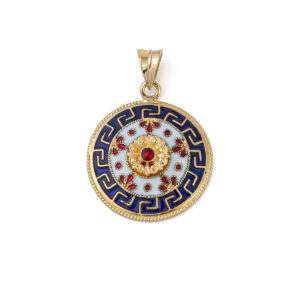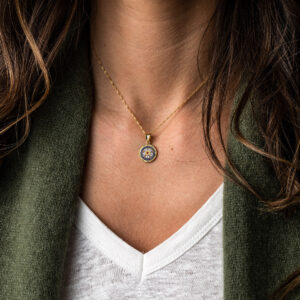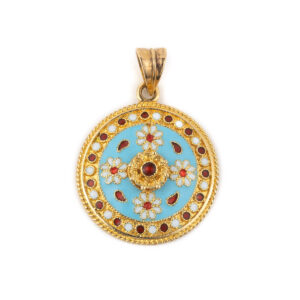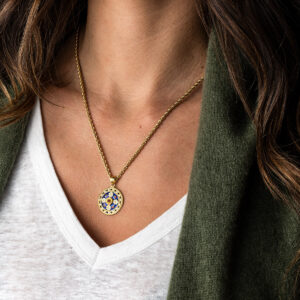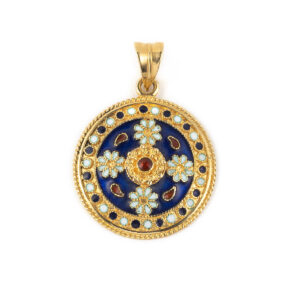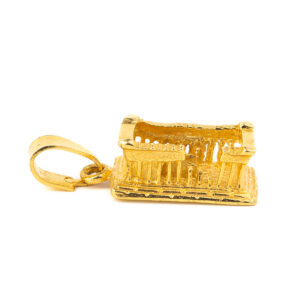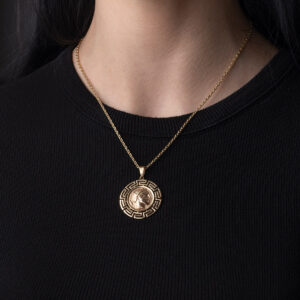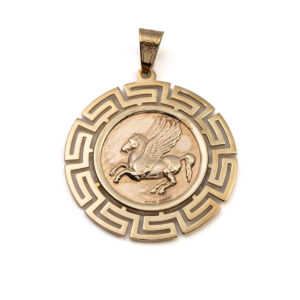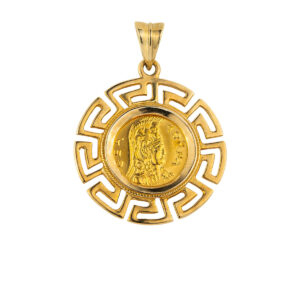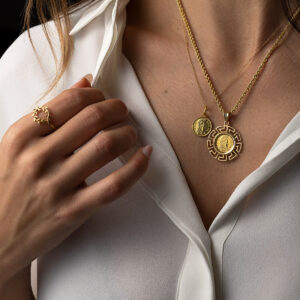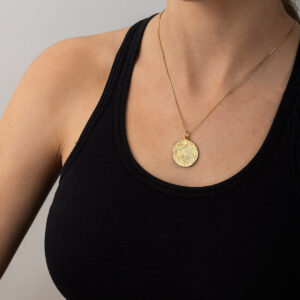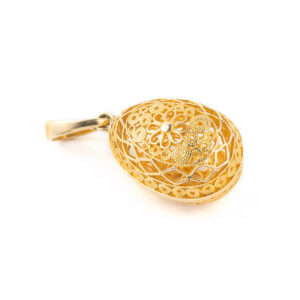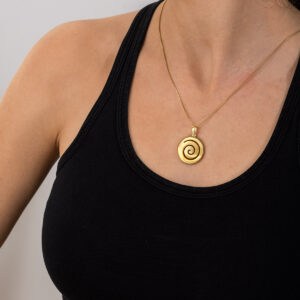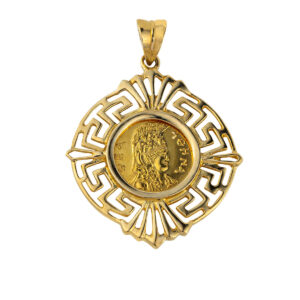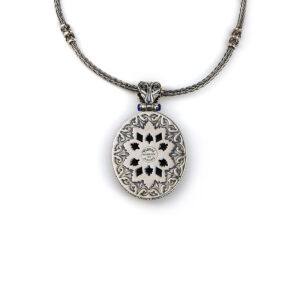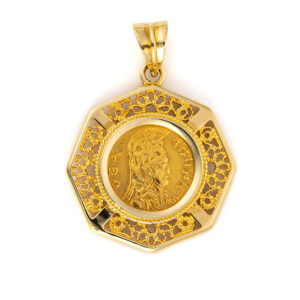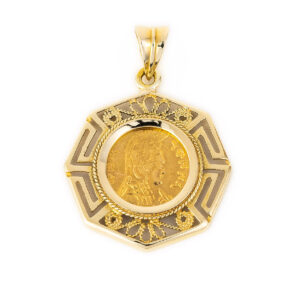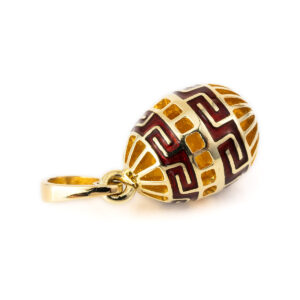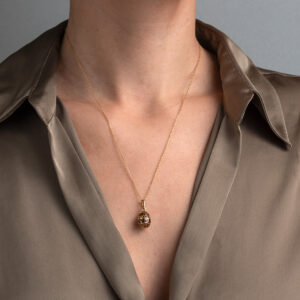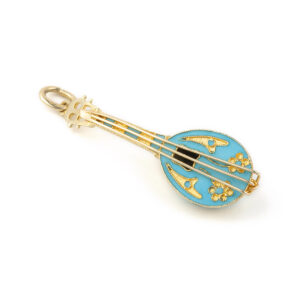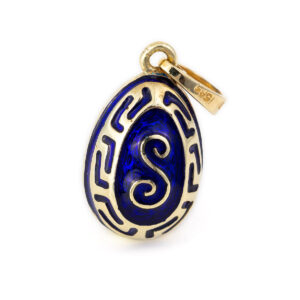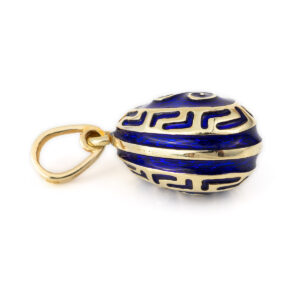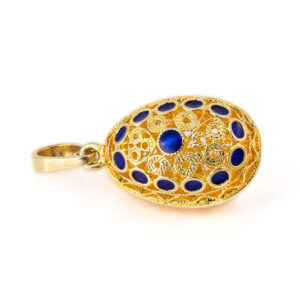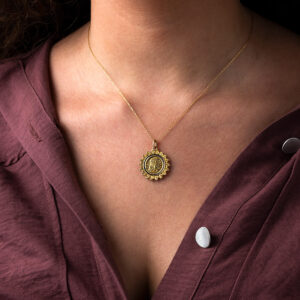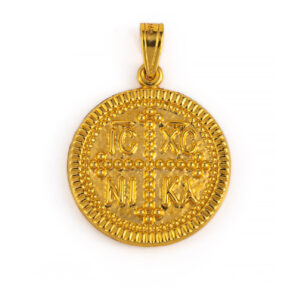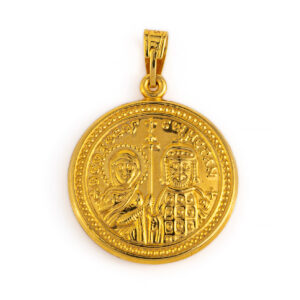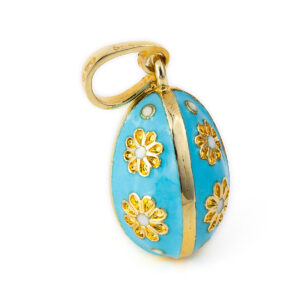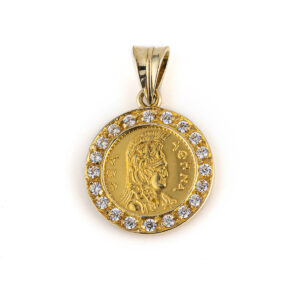Μενταγιόν
Μενταγιόν με Αθηνά – Χρυσό 14Κ
2.108,00€Α beautiful and timeless Coin Pendant with Goddess Athena.
The back side is decorated with the inscription: Alexandrou in Greek fonts.
Made in 14k gold.
Dracma was the currency used in Greece during several periods in its history.
The tetradrachm was an Ancient Greek silver coin equivalent to fourdrachmae in Athens it replaced the earlier “heraldic” type of didrachms and it was in wide circulation from ca. 510 to ca. 38 BC.
This coin illustrate the portrait of Goddess. The inscription of Alexander is engraved on the reverse. Athena is an ancient Greek goddess associated with wisdom, handicraft, and warfare.
Athena was regarded as the patron and protectress of various cities across Greece, particularly the city of Athens, from which she most likely received her name. She’s usually shown in art wearing a helmet and holding a spear. Her major symbols include owls, olive trees, and snakes. Her temples were located atop the fortified Acropolis in the central part of the city. The Parthenon on the Athenian Acropolis is dedicated to her, along with numerous other temples and monuments. Her main festival in Athens was the Panathenaia, which was celebrated in midsummer and was the most important festival on the Athenian calendar.
In the classical Olympian pantheon, Athena was regarded as the favorite daughter of Zeus.As in all handmade items there may be small differences in weight and dimensions and this is what makes them unique and precious.
Μενταγιόν με Θεά Αθηνά – Χρυσό 14Κ
1.630,00€This coins illustrate the portrait of Goddess Athena on the one side and the wisdom owl on the other.
Α beautiful and timeless coin pendant.
Made of 14k gold.
The chain shown is not included.
Goddess Athena and Owl – Athenian silver tetradrachm.
Dracma was the currency used in Greece during several periods in its history. The tetradrachm was an Ancient Greek silver coin equivalent to fourdrachmae in Athens it replaced the earlier “heraldic” type of didrachms and it was in wide circulation from ca. 510 to ca. 38 BC. This coin belongs to the so-called “new style Athenian coins” minted between 166 and 64 B.C. and is considered one of the most popular ancient Greek coins which illustrate the portrait of Goddess Athena on the one side and the wisdom owl on the other. Athena is an ancient Greek goddess associated with wisdom, handicraft, and warfare. Athena was regarded as the patron and protectress of various cities across Greece, particularly the city of Athens, from which she most likely received her name. She’s usually shown in art wearing a helmet and holding a spear. Her major symbols include owls, olive trees, and snakes. Her temples were located atop the fortified Acropolis in the central part of the city. The Parthenon on the Athenian Acropolis is dedicated to her, along with numerous other temples and monuments. Her main festival in Athens was the Panathenaia, which was celebrated in midsummer and was the most important festival on the Athenian calendar. In the classical Olympian pantheon, Athena was regarded as the favorite daughter of Zeus. The owl traditionally accompanies Athena. Because of such association, the owl has been used as a symbol of knowledge and wisdom. The inscriptions contain the city’s “national” appellation (“ΑΘΕ», i.e. “of the Athenians”).As in all handmade items there may be small differences in weight and dimensions and this is what makes them unique and precious.
Μενταγιόν Αθηνά – Χρυσό 14Κ
1.560,00€This coins illustrate the portrait of Goddess Athena on the one side and the wisdom owl on the other.
Α beautiful and timeless coin pendant.
Made of 14k gold.
The chain shown is our 14K Gold Rope Chain (not included).
Goddess Athena and Owl – Athenian silver tetradrachm.
Dracma was the currency used in Greece during several periods in its history. The tetradrachm was an Ancient Greek silver coin equivalent to fourdrachmae in Athens it replaced the earlier “heraldic” type of didrachms and it was in wide circulation from ca. 510 to ca. 38 BC. This coin belongs to the so-called “new style Athenian coins” minted between 166 and 64 B.C. and is considered one of the most popular ancient Greek coins which illustrate the portrait of Goddess Athena on the one side and the wisdom owl on the other. Athena is an ancient Greek goddess associated with wisdom, handicraft, and warfare. Athena was regarded as the patron and protectress of various cities across Greece, particularly the city of Athens, from which she most likely received her name. She’s usually shown in art wearing a helmet and holding a spear. Her major symbols include owls, olive trees, and snakes. Her temples were located atop the fortified Acropolis in the central part of the city. The Parthenon on the Athenian Acropolis is dedicated to her, along with numerous other temples and monuments. Her main festival in Athens was the Panathenaia, which was celebrated in midsummer and was the most important festival on the Athenian calendar. In the classical Olympian pantheon, Athena was regarded as the favorite daughter of Zeus. The owl traditionally accompanies Athena. Because of such association, the owl has been used as a symbol of knowledge and wisdom. The inscriptions contain the city’s “national” appellation (“ΑΘΕ», i.e. “of the Athenians”).As in all handmade items there may be small differences in weight and dimensions and this is what makes them unique and precious.
Parthenon Temple Charm Pendant – 18k Gold
440,00€ – 1.344,00€Yellow gold charm depicts the monument of the Parthenon, the main monument in Acropolis. Built in honor of the goddess Athena, and is the brightest monument of the Athenian.
Used as a charm on a bracelet or as a pendant on a chain.
Available in 3 sizes.
Made in 18k yellow gold.
Handmade item.
The chain shown is our 14K Gold Box Chain (not included).
Μενταγιόν Αμφορέας – 14Κ Χρυσό
1.309,00€Ancient Greek Amphora Pendant with blue enamel.
Design inspired by the ancient Greek history.
Made in 14k yellow gold
Also available with turquoise or green enamel
Handmade item
Amphora is a Greco – Roman word developed in ancient Greek during the Bronze Age. An amphora is a type of container of a characteristic shape and size. Amphorae were used for the transport and storage of various products, both liquid and dry, but mostly for wine. They are most often ceramic. the amphorae used in Ancient Greek vase painting. (source wikipedia)
Μενταγιόν Μαίανδρος από χρυσό 18Κ με Μπλε Σμάλτο
1.275,00€Αρχαίο Ελληνικό Μενταγιόν Στρογγυλό με μπλε σμάλτο.
Η πίσω πλευρά του μενταγιόν δεν έχει διακόσμηση.
Σχεδιασμός εμπνευσμένος από την απίστευτη ομορφιά της ιστορικής μας παράδοσης.
Κατασκευασμένο από χρυσό 18 καρατίων.
Η αλυσίδα που απεικονίζεται είναι η δική μας.
Χειροποίητο Ελληνικό Κόσμημα
Ανακαλύψτε τη Συλλογή Βυζάντιο
18Κ Χρυσό Τυρκουάζ Μενταγιόν με Αρχαια Ελληνική Ροζέτα
1.197,00€Αρχαίο Ελληνικό Στρογγυλό Μενταγιόν με φλοράλ μοτίβο (τέσσερα μοτίβα ροζέτα). Το μενταγιόν είναι διακοσμημένο με τυρκουάζ & κόκκινο σμάλτο και κόκκους πολύτιμου μετάλλου. Η πίσω πλευρά του μενταγιόν δεν έχει διακόσμηση.
Σχεδιασμός εμπνευσμένος από την απίστευτη ομορφιά της ιστορικής παράδοσης.
Από χρυσό 18 καρατίων.
Διατίθεται επίσης με μπλε σμάλτο.
Χειροποίητο ελληνικό κόσμημα.
Η αλυσίδα που απεικονίζεται είναι η 14K χρυσή αλυσίδα rope (δεν περιλαμβάνεται).
Ο ροζέτα (τριαντάφυλλο) είναι ένα διαχρονικό κόσμημα, σύμβολο και φυλαχτό.
Η προέλευση του όρου είναι η ελληνική λέξη για το τριαντάφυλλο – rodon (ρόδον). Η χρήση του ξεκίνησε στη μυκηναϊκή εποχή και συνεχίζεται μέχρι τη 2η χιλιετία π.Χ. Η μυκηναϊκή ρόδα είναι ένα μοτίβο που ήταν ευρέως διαδεδομένο σε όλη τη Μεσοποταμία, την Αίγυπτο, την Ελλάδα και άλλους αρχαίους πολιτισμούς. Είναι εμπνευσμένο από μια χάντρα με μυκηναϊκή ροζέτα, που βρέθηκε στις Μυκήνες και χρονολογείται στο 1400-1300 π.Χ. Η ροζέτα χρησιμοποιήθηκε εκτενώς στα αρχαία ελληνικά μυκηναϊκά κοσμήματα, στην αρχιτεκτονική, στην κεραμική και στα γλυπτά από το 1500 π.Χ. Οι μυκηναϊκοί ρόδακες είχαν συνήθως 6 ή 8 ή 12 φύλλα και δεκαέξι φύλλα κατά τη διάρκεια της Μακεδονικής Δυναστείας. Τέτοιες λεπτομέρειες όπως το σχήμα του ρόδακα και ο αριθμός των φύλλων τείνουν να ποικίλλουν ανάλογα με την εποχή ή τις δοξασίες. Οι ρόδακες χρησιμοποιούνταν για τη διακόσμηση των υφασμάτων, των ζωνών και των στεφάνων των βασιλέων. Ο αριθμός των φύλλων είχε συμβολικό χαρακτήρα κάθε φορά. Τα τέσσερα στοιχεία της φύσης (άνεμος, γη, φωτιά, νερό), τα επτά θαύματα του αρχαίου κόσμου ή οι δώδεκα θεοί των αρχαίων Ελλήνων και η παγκόσμια κυριαρχία και ακτινοβολία των βασιλιάδων της Μακεδονίας. Ήταν σημάδια ομορφιάς, αγνότητας, ευζωίας, λατρείας και εξουσίας. Η ροζέτα ή ρόδαξ ήταν ίσως το πιο δημοφιλές και αγαπημένο διακοσμητικό στοιχείο στη μυκηναϊκή εποχή, την κλασική αρχαιότητα και τους βυζαντινούς χρόνους.
18Κ Χρυσό Μπλε Μενταγιόν με Αρχαια Ελληνική Ροζέτα
1.197,00€Αρχαίο Ελληνικό Στρογγυλό Μενταγιόν με φλοράλ μοτίβο (τέσσερα μοτίβα ροζέτα). Το μενταγιόν είναι διακοσμημένο με τυρκουάζ & κόκκινο σμάλτο και κόκκους πολύτιμου μετάλλου. Η πίσω πλευρά του μενταγιόν δεν έχει διακόσμηση.
Σχεδιασμός εμπνευσμένος από την απίστευτη ομορφιά της ιστορικής παράδοσης.
Από χρυσό 18 καρατίων.
Διατίθεται επίσης με τυρκουάζ σμάλτο.
Χειροποίητο ελληνικό κόσμημα.
Η αλυσίδα που απεικονίζεται είναι η 14K χρυσή αλυσίδα rope (δεν περιλαμβάνεται).
Ο ροζέτα (τριαντάφυλλο) είναι ένα διαχρονικό κόσμημα, σύμβολο και φυλαχτό.
Η προέλευση του όρου είναι η ελληνική λέξη για το τριαντάφυλλο – rodon (ρόδον). Η χρήση του ξεκίνησε στη μυκηναϊκή εποχή και συνεχίζεται μέχρι τη 2η χιλιετία π.Χ. Η μυκηναϊκή ρόδα είναι ένα μοτίβο που ήταν ευρέως διαδεδομένο σε όλη τη Μεσοποταμία, την Αίγυπτο, την Ελλάδα και άλλους αρχαίους πολιτισμούς. Είναι εμπνευσμένο από μια χάντρα με μυκηναϊκή ροζέτα, που βρέθηκε στις Μυκήνες και χρονολογείται στο 1400-1300 π.Χ. Η ροζέτα χρησιμοποιήθηκε εκτενώς στα αρχαία ελληνικά μυκηναϊκά κοσμήματα, στην αρχιτεκτονική, στην κεραμική και στα γλυπτά από το 1500 π.Χ. Οι μυκηναϊκοί ρόδακες είχαν συνήθως 6 ή 8 ή 12 φύλλα και δεκαέξι φύλλα κατά τη διάρκεια της Μακεδονικής Δυναστείας. Τέτοιες λεπτομέρειες όπως το σχήμα του ρόδακα και ο αριθμός των φύλλων τείνουν να ποικίλλουν ανάλογα με την εποχή ή τις δοξασίες. Οι ρόδακες χρησιμοποιούνταν για τη διακόσμηση των υφασμάτων, των ζωνών και των στεφάνων των βασιλέων. Ο αριθμός των φύλλων είχε συμβολικό χαρακτήρα κάθε φορά. Τα τέσσερα στοιχεία της φύσης (άνεμος, γη, φωτιά, νερό), τα επτά θαύματα του αρχαίου κόσμου ή οι δώδεκα θεοί των αρχαίων Ελλήνων και η παγκόσμια κυριαρχία και ακτινοβολία των βασιλιάδων της Μακεδονίας. Ήταν σημάδια ομορφιάς, αγνότητας, ευζωίας, λατρείας και εξουσίας. Η ροζέτα ή ρόδαξ ήταν ίσως το πιο δημοφιλές και αγαπημένο διακοσμητικό στοιχείο στη μυκηναϊκή εποχή, την κλασική αρχαιότητα και τους βυζαντινούς χρόνους.
Μενταγιόν Παρθενώνας από Χρυσό Κ14
357,00€ – 1.088,00€Φτιαγμένο από χρυσό 14κ.
Η αλυσίδα δεν περιλαμβάνεται.
Χειροποίητο Ελληνικό Κόσμημα
Χρησιμοποιείται ως φυλακτό σε βραχιόλι ή ως μενταγιόν σε αλυσίδα.
Διατίθεται σε 3 μεγέθη.
Ανακαλύψτε τη συλλογή Κληρονομιά
Ιστορία
Ο Παρθενώνας είναι ναός ο οποίος κατασκευάστηκε το 448/7 π.Χ προς τιμήν της θεάς Αθηνάς, προστάτιδας της πόλης της Αθήνας. Υπήρξε το αποτέλεσμα της συνεργασίας σημαντικών αρχιτεκτόνων και γλυπτών στα μέσα του 5ου π.Χ. αιώνα. Οι αρχιτέκτονες του Παρθενώνα ήταν ο Ικτίνος και ο Καλλικράτης. Ο Παρθενώνας αποτελεί το λαμπρότερο μνημείο της Αθηναϊκής πολιτείας.
Μενταγιόν Παρθενώνας από Χρυσό Κ14
Φτιαγμένο από χρυσό 14κ.
Η αλυσίδα δεν περιλαμβάνεται.
Χειροποίητο Ελληνικό Κόσμημα
Χρησιμοποιείται ως φυλακτό σε βραχιόλι ή ως μενταγιόν σε αλυσίδα.
Διατίθεται σε 3 μεγέθη.
Ανακαλύψτε τη συλλογή Κληρονομιά
Ιστορία
Ο Παρθενώνας είναι ναός ο οποίος κατασκευάστηκε το 448/7 π.Χ προς τιμήν της θεάς Αθηνάς, προστάτιδας της πόλης της Αθήνας. Υπήρξε το αποτέλεσμα της συνεργασίας σημαντικών αρχιτεκτόνων και γλυπτών στα μέσα του 5ου π.Χ. αιώνα. Οι αρχιτέκτονες του Παρθενώνα ήταν ο Ικτίνος και ο Καλλικράτης. Ο Παρθενώνας αποτελεί το λαμπρότερο μνημείο της Αθηναϊκής πολιτείας.
Μενταγιόν Αυγό Φιλιγκράν με Λουλούδια – Χρυσός 14Κ και Τυρκουάζ Σμάλτο
612,00€ – 952,00€Το μενταγιόν είναι διακοσμημένο με λουλούδια σε στυλ Faberge.
Χρησιμοποιείται ως γούρι ή ως μενταγιόν.
Διαλέξτε ένα όμορφο δώρο εμπνευσμένο από τη μεγαλοπρεπή τέχνη της Fabergé!
Κατασκευασμένο από χρυσό 14 καρατίων και τυρκουάζ σμάλτο.
Η αλυσίδα που απεικονίζεται είναι η 14Κ Gourmet Χρυσή Αλυσίδα μας (δεν περιλαμβάνεται).
Η ροζέτα (τριαντάφυλλο) είναι ένα διαχρονικό κόσμημα, σύμβολο και φυλαχτό. Η προέλευση του όρου είναι η ελληνική λέξη για το τριαντάφυλλο – rodon (ρόδον). Η χρήση του ξεκίνησε στη μυκηναϊκή εποχή και συνεχίζεται μέχρι τη 2η χιλιετία π.Χ. Η μυκηναϊκή ρόδα είναι ένα μοτίβο που ήταν ευρέως διαδεδομένο σε όλη τη Μεσοποταμία, την Αίγυπτο, την Ελλάδα και άλλους αρχαίους πολιτισμούς. Η ροζέτα ή Ροδάξ ήταν ίσως το πιο δημοφιλές και αγαπημένο διακοσμητικό στοιχείο στη μυκηναϊκή εποχή, την κλασική αρχαιότητα και τους βυζαντινούς χρόνους.
Το αυγό Φαμπερζέ είναι ένα αυγό κοσμήμα που δημιουργήθηκε από τον οίκο Φαμπερζέ, στην Αγία Πετρούπολη της αυτοκρατορικής Ρωσίας. Σχεδόν όλα κατασκευάστηκαν υπό την επίβλεψη του Πέτερ Καρλ Φαμπερζέ μεταξύ 1885 και 1917,[παραπομπή απαιτείται] με πιο διάσημα τα 50 «αυτοκρατορικά» αυγά, 43 από τα οποία σώζονται, που κατασκευάστηκαν για τους Ρώσους τσάρους Αλέξανδρο Γ’ και Νικόλαο Β’ ως πασχαλινά δώρα για τις συζύγους και τις μητέρες τους. Το πρώτο αυγό Φαμπερζέ φιλοτεχνήθηκε για τον τσάρο Αλέξανδρο Γ΄, ο οποίος είχε αποφασίσει να χαρίσει στη σύζυγό του, την αυτοκράτειρα Μαρία Φεοντόροβνα, ένα πασχαλινό αυγό το 1885. Ο Peter Carl Fabergé ήταν ένας Ρώσος κοσμηματοπώλης, γνωστός κυρίως για τα περίφημα αυγά Fabergé που κατασκευάστηκαν στο στυλ των γνήσιων πασχαλινών αυγών, χρησιμοποιώντας πολύτιμα μέταλλα και πολύτιμους λίθους. Είναι ο ιδρυτής της διάσημης κληρονομιάς κοσμημάτων του οίκου Fabergé.
Όπως σε όλα τα χειροποίητα κοσμήματα μπορεί να υπάρχουν μικρές διαφορές στο βάρος και τις διαστάσεις και αυτό είναι που τα κάνει μοναδικά και πολύτιμα.
Μενταγιόν Μέγας Αλέξανδρος – Χρυσό 14Κ
945,00€Κατασκευασμένο από Χρυσό 14Κ.
Χειροποίητο ελληνικό κόσμημα.
Αυτό το Αρχαίο Ελληνικό νόμισμα αντιπροσωπεύει τον Μέγα Αλέξανδρο από τη μία πλευρά και τον Λυσίμαχο από την άλλη. Ο Μέγας Αλέξανδρος ο Βασιλιάς της Μακεδονίας θεωρείται μία από τις σημαντικότερες μορφές της παγκόσμιας ιστορίας. Ο Λυσίμαχος ήταν Μακεδόνας αξιωματικός και διάδοχος του Μεγάλου Αλεξάνδρου, ο οποίος έγινε βασιλέας το 306 π.Χ., κυβερνώντας τη Θράκη, τη Μικρά Ασία και τη Μακεδονία.
Μενταγιόν Θεά Αθηνά – Χρυσό 14Κ
945,00€Κατασκευασμένο από Χρυσό 14Κ.
Χειροποίητο ελληνικό κόσμημα.
Αυτό το νόμισμα ανήκει στα λεγόμενα «αθηναϊκά νομίσματα νέου στυλ» που κόπηκαν μεταξύ 166 και 64 π.Χ. και θεωρείται ένα από τα πιο δημοφιλή αρχαία ελληνικά νομίσματα που απεικονίζουν το πορτρέτο της Θεάς Αθηνάς. Η Αθηνά σχετίζεται με τη σοφία, τη χειροτεχνία και τον πόλεμο. Η Αθηνά θεωρούνταν προστάτιδα διαφόρων πόλεων σε όλη την Ελλάδα, αλλά ιδιαίτερα της Αθήνας, η οποία πήρε το όνομά της από εκείνη. Συνήθως εμφανίζεται στην τέχνη φορώντας κράνος και κρατώντας ένα δόρυ. Τα κύρια σύμβολά της περιλαμβάνουν κουκουβάγιες, ελιές και φίδια. Οι ναοί της βρίσκονταν στην οχυρωμένη Ακρόπολη στο κεντρικό τμήμα της πόλης. Ο Παρθενώνας στην Ακρόπολη της Αθήνας είναι αφιερωμένος σε αυτήν, μαζί με πολλούς άλλους ναούς και μνημεία. Το κύριο πανηγύρι της στην Αθήνα ήταν τα Παναθήναια, τα οποία γιορτάζονταν το καλοκαίρι και ήταν το σημαντικότερο πανηγύρι του αθηναϊκού ημερολογίου. Στο κλασικό Ολύμπιο πάνθεον, η Αθηνά θεωρούνταν η αγαπημένη κόρη του Δία. Η κουκουβάγια συνοδεύει παραδοσιακά την Αθηνά. Λόγω αυτής της συσχέτισης, η κουκουβάγια έχει χρησιμοποιηθεί ως σύμβολο γνώσης και σοφίας. Οι επιγραφές περιέχουν την «εθνική» ονομασία της πόλης («ΑΘΕ», δηλαδή «των Αθηναίων»).
Μενταγιόν Πήγασος – Χρυσό 14Κ
945,00€Κατασκευασμένο από Χρυσό 14Κ.
Χειροποίητο ελληνικό κόσμημα.
Ο Πήγασος είναι ένας μυθικός φτερωτός θεϊκός επιβήτορας και ένα από τα πιο αναγνωρισμένα πλάσματα στην ελληνική μυθολογία. Συνήθως απεικονίζεται σε λευκό χρώμα, ο Πήγασος είναι παιδί του Ολύμπιου Θεού Ποσειδώνα.
Μενταγιόν Θεά Αθηνά – Χρυσό 14Κ
918,00€This coins illustrate the portrait of Goddess Athena on the one side and the wisdom owl on the other.
Α beautiful and timeless coin pendant.
Made of 14k gold.
The chain shown is our 14K Gold Chain in Length 45cm – 50cm – 55cm (not included)
Goddess Athena and Owl – Athenian silver tetradrachm.
Dracma was the currency used in Greece during several periods in its history. The tetradrachm was an Ancient Greek silver coin equivalent to fourdrachmae in Athens it replaced the earlier “heraldic” type of didrachms and it was in wide circulation from ca. 510 to ca. 38 BC. This coin belongs to the so-called “new style Athenian coins” minted between 166 and 64 B.C. and is considered one of the most popular ancient Greek coins which illustrate the portrait of Goddess Athena on the one side and the wisdom owl on the other. Athena is an ancient Greek goddess associated with wisdom, handicraft, and warfare. Athena was regarded as the patron and protectress of various cities across Greece, particularly the city of Athens, from which she most likely received her name. She’s usually shown in art wearing a helmet and holding a spear. Her major symbols include owls, olive trees, and snakes. Her temples were located atop the fortified Acropolis in the central part of the city. The Parthenon on the Athenian Acropolis is dedicated to her, along with numerous other temples and monuments. Her main festival in Athens was the Panathenaia, which was celebrated in midsummer and was the most important festival on the Athenian calendar. In the classical Olympian pantheon, Athena was regarded as the favorite daughter of Zeus. The owl traditionally accompanies Athena. Because of such association, the owl has been used as a symbol of knowledge and wisdom. The inscriptions contain the city’s “national” appellation (“ΑΘΕ», i.e. “of the Athenians”).As in all handmade items there may be small differences in weight and dimensions and this is what makes them unique and precious.
Βυζαντινό Μενταγιόν Lapis Lazuli Ασήμι 925 – Yianni Jewelry
A pendant inspired by a Byzantine design, decorated with Lapis Lazuli gemstone.
Made of 925° sterling silver.
Handmade Item.
The chain shown is not included but is available in our store.
These silver creations of Yianni Jewelry, created by Garbis Khacherian, a silversmith trader since 1987.
Μενταγιόν Φαιστός – 14Κ Χρυσό
204,00€ – 850,00€Κατασκευασμένο από 14Κ χρυσό.
Ο Δίσκος της Φαιστού είναι ένας δίσκος από πηλό από το μινωικό παλάτι της Φαιστού στο νησί της Κρήτης. Τώρα, το νησί της Κρήτης είναι μέρος της σύγχρονης Ελλάδας. Ο δίσκος ανακαλύφθηκε το 1908 από τον Ιταλό αρχαιολόγο Luigi Pernier στο μινωικό παλάτι της Φαιστού. Ακόμα και στις μέρες μας η αποκρυπτογράφηση του δεν είναι ξεκάθαρη, καθιστώντας το ένα από τα πιο διάσημα μυστήρια της αρχαιολογίας. Ο δίσκος έχει διάμετρο περίπου 15 εκατοστά και καλύπτεται και στις δύο πλευρές με μια σπείρα από σφραγισμένα σύμβολα. Ο δίσκος διαθέτει 241 μάρκες, που περιλαμβάνουν 45 ξεχωριστά σημάδια, τα οποία φτιάχτηκαν προφανώς πιέζοντας ιερογλυφικές «σφραγίδες» σε ένα δίσκο από μαλακό πηλό, με μια δεξιόστροφη ακολουθία που στρέφεται προς το κέντρο του δίσκου. Αυτό το μοναδικό αντικείμενο εκτίθεται τώρα στο αρχαιολογικό μουσείο Ηρακλείου.
Χειροποίητο ελληνικό κόσμημα.
Μενταγιόν Αυγό – 14Κ Χρυσό
442,00€ – 850,00€The pendant is embellished with a fine filigree and rosette motif in Faberge style.
Used as a charm or as a pendant.
Pick up a beautiful gift inspired by the majestic art of Fabergé!
Made in 14k yellow gold
Available in 4 sizes.
The chain shown is our 14K Gold Chain (not included).
The rosette (rose) is a timeless jewel, symbol and amulet. The origin of the term is the Greek word for rose – rodon (ρόδον). Its use began in the Mycenaean era and continues as far as the 2nd millennia BC. The Mycenaean Rosette is a motif that was widespread throughout Mesopotamia, Egypt, Greece and other ancient civilizations. Rosette or Rodax was probably the most popular and favorite decorative element in Mycenaean era, classical antiquity and Byzantine times.
Filigree is a delicate kind of jewellery metalwork, made with tiny beads or twisted threads, or both in combination, soldered together or to the surface of an object of the same metal and arranged in artistic motifs. The art of filigree dates back to ancient history. The first of the found jewelry in this technique have been found in Mesopotamia and dates to thousands of years BC. In the ancient world and particularly in Asia Minor, this art grew were at the highest level.
Fabergé egg is a jeweled egg created by the House of Fabergé, in St. Petersburg, Imperial Russia. Virtually all were manufactured under the supervision of Peter Carl Fabergé between 1885 and 1917,[citation needed] the most famous being the 50 “Imperial” eggs, 43 of which survive, made for the Russian Tsars Alexander III and Nicholas II as Easter gifts for their wives and mothers. The first Fabergé egg was crafted for Tsar Alexander III, who had decided to give his wife, the Empress Maria Feodorovna, an Easter egg in 1885. Peter Carl Fabergé was a Russian jeweller best known for the famous Fabergé eggs made in the style of genuine Easter eggs, using precious metals and gemstones. He’s the founder of the famous jewelry legacy House of Fabergé.
Μενταγιόν Σπείρα – 14Κ Χρυσό
340,00€ – 850,00€Spiral Pendant in 14k Gold.
The spiral is one of the oldest symbols of human spirituality, carved or painted into rocks from thousands of years ago. Symbol of movement and progressive development, growth, expansion, cosmic energy, symbol of the sun..Spirals have been found in burial sites, uin vases, in jewelry, clothing, weapons… They can be seen in every aspect in nature, like the tides in the oceans, the winds, the plants, the shells. The spiral phenomenon has been explained thought mathematics from the time of Archimedes, the great Greek mathematician.
Handmade item.
The chain shown is our 14K Gold Box Chain (not included).
Μενταγιόν με Αθηνά και Μαίανδρο – Χρυσό 14Κ
848,00€This coins illustrate the portrait of Goddess Athena on the one side and the wisdom owl on the other.
Α beautiful and timeless coin pendant.
Made of 14k gold.
Goddess Athena and Owl – Athenian silver tetradrachm.
Dracma was the currency used in Greece during several periods in its history. The tetradrachm was an Ancient Greek silver coin equivalent to fourdrachmae in Athens it replaced the earlier “heraldic” type of didrachms and it was in wide circulation from ca. 510 to ca. 38 BC. This coin belongs to the so-called “new style Athenian coins” minted between 166 and 64 B.C. and is considered one of the most popular ancient Greek coins which illustrate the portrait of Goddess Athena on the one side and the wisdom owl on the other. Athena is an ancient Greek goddess associated with wisdom, handicraft, and warfare. Athena was regarded as the patron and protectress of various cities across Greece, particularly the city of Athens, from which she most likely received her name. She’s usually shown in art wearing a helmet and holding a spear. Her major symbols include owls, olive trees, and snakes. Her temples were located atop the fortified Acropolis in the central part of the city. The Parthenon on the Athenian Acropolis is dedicated to her, along with numerous other temples and monuments. Her main festival in Athens was the Panathenaia, which was celebrated in midsummer and was the most important festival on the Athenian calendar. In the classical Olympian pantheon, Athena was regarded as the favorite daughter of Zeus. The owl traditionally accompanies Athena. Because of such association, the owl has been used as a symbol of knowledge and wisdom. The inscriptions contain the city’s “national” appellation (“ΑΘΕ», i.e. “of the Athenians”).As in all handmade items there may be small differences in weight and dimensions and this is what makes them unique and precious.
Μενταγιόν με Αθηνά και Μαίανδρο – Χρυσό 14Κ
816,00€This coin illustrates the portrait of Goddess Athena on the one side and the wisdom owl on the other.
Α beautiful and timeless coin pendant.
Made of 14k gold.
The chain shown is not included.
Goddess Athena and Owl – Athenian silver tetradrachm.
Dracma was the currency used in Greece during several periods in its history. The tetradrachm was an Ancient Greek silver coin equivalent to fourdrachmae in Athens it replaced the earlier “heraldic” type of didrachms and it was in wide circulation from ca. 510 to ca. 38 BC. This coin belongs to the so-called “new style Athenian coins” minted between 166 and 64 B.C. and is considered one of the most popular ancient Greek coins which illustrate the portrait of Goddess Athena on the one side and the wisdom owl on the other. Athena is an ancient Greek goddess associated with wisdom, handicraft, and warfare. Athena was regarded as the patron and protectress of various cities across Greece, particularly the city of Athens, from which she most likely received her name. She’s usually shown in art wearing a helmet and holding a spear. Her major symbols include owls, olive trees, and snakes. Her temples were located atop the fortified Acropolis in the central part of the city. The Parthenon on the Athenian Acropolis is dedicated to her, along with numerous other temples and monuments. Her main festival in Athens was the Panathenaia, which was celebrated in midsummer and was the most important festival on the Athenian calendar. In the classical Olympian pantheon, Athena was regarded as the favorite daughter of Zeus. The owl traditionally accompanies Athena. Because of such association, the owl has been used as a symbol of knowledge and wisdom. The inscriptions contain the city’s “national” appellation (“ΑΘΕ», i.e. “of the Athenians”).As in all handmade items there may be small differences in weight and dimensions and this is what makes them unique and precious.
Βυζαντινό Μενταγιόν Lapis Ασήμι 925 – Yianni Jewelry
A pendant inspired by a Byzantine design, decorated with Lapis Lazuli gemstone.
Made of 925° sterling silver.
Handmade Item.
The chain shown is not included but is available in our store.
These silver creations of Yianni Jewelry, created by Garbis Khacherian, a silversmith trader since 1987.
Μενταγιόν Θεά Αθηνά – Χρυσό 14Κ
782,00€Θεά Αθηνά και Κουκουβάγια – Αθηναϊκό ασημένιο τετράδραχμο.
Κατασκευασμένο από 14Κ χρυσό.
Αυτό το νόμισμα ανήκει στα λεγόμενα «αθηναϊκά νομίσματα νέου στυλ» που κόπηκαν μεταξύ 166 και 64 π.Χ. και θεωρείται ένα από τα πιο δημοφιλή αρχαία ελληνικά νομίσματα που απεικονίζουν το πορτρέτο της Θεάς Αθηνάς. Η Αθηνά σχετίζεται με τη σοφία, τη χειροτεχνία και τον πόλεμο. Η Αθηνά θεωρούνταν προστάτιδα διαφόρων πόλεων σε όλη την Ελλάδα, αλλά ιδιαίτερα της Αθήνας, η οποία πήρε το όνομά της από εκείνη. Συνήθως εμφανίζεται στην τέχνη φορώντας κράνος και κρατώντας ένα δόρυ. Τα κύρια σύμβολά της περιλαμβάνουν κουκουβάγιες, ελιές και φίδια. Οι ναοί της βρίσκονταν στην οχυρωμένη Ακρόπολη στο κεντρικό τμήμα της πόλης. Ο Παρθενώνας στην Ακρόπολη της Αθήνας είναι αφιερωμένος σε αυτήν, μαζί με πολλούς άλλους ναούς και μνημεία. Το κύριο πανηγύρι της στην Αθήνα ήταν τα Παναθήναια, τα οποία γιορτάζονταν το καλοκαίρι και ήταν το σημαντικότερο πανηγύρι του αθηναϊκού ημερολογίου. Στο κλασικό Ολύμπιο πάνθεον, η Αθηνά θεωρούνταν η αγαπημένη κόρη του Δία. Η κουκουβάγια συνοδεύει παραδοσιακά την Αθηνά. Λόγω αυτής της συσχέτισης, η κουκουβάγια έχει χρησιμοποιηθεί ως σύμβολο γνώσης και σοφίας. Οι επιγραφές περιέχουν την «εθνική» ονομασία της πόλης («ΑΘΕ», δηλαδή «των Αθηναίων»).
Χειροποίητο ελληνικό κόσμημα.
Μενταγιόν Θεά Αθηνά – Χρυσός 14Κ
765,00€Κατασκευασμένο από χρυσό 14 καρατίων.
Η αλυσίδα που απεικονίζεται είναι η Χρυσή Αλυσίδα Spiga 14Κ (δεν περιλαμβάνεται).
Όπως σε όλα τα χειροποίητα αντικείμενα μπορεί να υπάρχουν μικρές διαφορές στο βάρος και τις διαστάσεις και αυτό είναι που τα κάνει μοναδικά και πολύτιμα.
Μενταγιόν Αυγό Μαίανδρος – Χρυσό 14Κ και Κόκκινο Σμάλτο
765,00€Το μενταγιόν είναι διακοσμημένο με το σχέδιο του μαίανδρου.
Χρησιμοποιείται ως γούρι ή ως μενταγιόν.
Πάρτε ένα όμορφο δώρο εμπνευσμένο από τη μεγαλοπρεπή τέχνη της Fabergé!
Κατασκευασμένο από χρυσό 14 καρατίων και κόκκινο σμάλτο.
Διατίθεται με μπλε ή πράσινο ή τυρκουάζ σμάλτο
Το σχέδιο Μαίανδρου είναι ένα διακοσμητικό περίγραμμα που κατασκευάζεται από μια συνεχή γραμμή, η οποία διαμορφώνεται σε ένα επαναλαμβανόμενο μοτίβο. Ένα τέτοιο σχέδιο αποκαλείται επίσης σχέδιο ελληνικού κροσσού ή ελληνικού κλειδιού, αν και πρόκειται για σύγχρονες ονομασίες. Από τη μία πλευρά, το όνομα «μαιάνδρος» θυμίζει τη στριμμένη και στρεφόμενη διαδρομή του ποταμού Μαιάνδρου στη Μικρά Ασία, και από την άλλη πλευρά, όπως τόνισε ο Karl Kerenyi, «ο μαιάνδρος είναι το σχήμα ενός λαβύρινθου σε γραμμική μορφή» το νόημα είναι ότι αυτά δεν υπάρχει αρχή και να τελειώσει τέλος σε ορισμένες περιπτώσεις, έτσι ώστε να γίνει το σύμβολο της μακράς ζωής και της αιωνιότητας.
Το αυγό Fabergé είναι ένα αυγό κόσμημα που δημιουργήθηκε από τον οίκο Fabergé, στην Αγία Πετρούπολη της αυτοκρατορικής Ρωσίας. Σχεδόν όλα κατασκευάστηκαν υπό την επίβλεψη του Πέτερ Καρλ Φαμπερζέ μεταξύ 1885 και 1917,[παραπομπή απαιτείται] με πιο διάσημα τα 50 «αυτοκρατορικά» αυγά, 43 από τα οποία σώζονται, που κατασκευάστηκαν για τους Ρώσους τσάρους Αλέξανδρο Γ’ και Νικόλαο Β’ ως πασχαλινά δώρα για τις συζύγους και τις μητέρες τους. Το πρώτο αυγό Φαμπερζέ φιλοτεχνήθηκε για τον τσάρο Αλέξανδρο Γ΄, ο οποίος είχε αποφασίσει να χαρίσει στη σύζυγό του, την αυτοκράτειρα Μαρία Φεοντόροβνα, ένα πασχαλινό αυγό το 1885. Ο Peter Carl Fabergé ήταν ένας Ρώσος κοσμηματοπώλης, γνωστός κυρίως για τα περίφημα αυγά Fabergé που κατασκευάστηκαν στο στυλ των γνήσιων πασχαλινών αυγών, χρησιμοποιώντας πολύτιμα μέταλλα και πολύτιμους λίθους. Είναι ο ιδρυτής της διάσημης κληρονομιάς κοσμημάτων του οίκου Fabergé.
Όπως σε όλα τα χειροποίητα κοσμήματα, ενδέχεται να υπάρχουν μικρές διαφορές στο βάρος και τις διαστάσεις, γεγονός που τα καθιστά μοναδικά και πολύτιμα.
Μενταγιόν Μπουζούκι – 14Κ Χρυσό
730,00€Greek Bouzouki Charm with turquoise enamel. The pendant is decorated with rosette motifs.
Made in 14k yellow gold.
Used as a charm or as a pendant.
Design inspired by the Greek tradition
The Greek bouzouki is a plucked musical instrument of the lute family, called the thabouras or tambouras family. The tambouras has existed in ancient Greece as pandoura, and can be found in various sizes and shapes. The bouzouki and the baglamas are the direct descendants. The bouzouki arrived in Greece following the 1919–1922 war in Asia Minor and the subsequent exchange of populations between Greece and Turkey when the ethnic Greeks fled to Greece. At the end of the 1950s, four-course (tetrachordo) bouzoukia started to gain popularity. The four-course bouzouki was made popular by Manolis Chiotis. Manolis Chiotis was a Greek rebetiko and laiko composer, singer, and bouzouki player. He is considered one of the greatest bouzouki soloists of all time. In the summer of 1961, he played for Aristotle Onassis and Maria Callas and Grace Kelly. Callas told Chiotis that she had been translating the lyrics of his songs to Princess Grace all night long and the American actress loved them because “she is a woman in love.” At that moment, Kelly asked Chiotis what the difference between a bouzouki and an electric guitar is. Chiotis’ answer was rather unexpected; “Mrs. Callas, please explain to Princess Grace that the strings of an electric guitar vibrate due to electricity, while the strings of a bouzouki vibrate through the heart.” *
The rosette (rose) is a timeless jewel, symbol and amulet. The origin of the term is the Greek word for rose – rodon (ρόδον). Its use began in the Mycenaean era and continues as far as the 2nd millennia BC. The Mycenaean Rosette is a motif that was widespread throughout Mesopotamia, Egypt, Greece and other ancient civilizations. Rosette or Rodax was probably the most popular and favorite decorative element in Mycenaean era, classical antiquity and Byzantine times.
Μενταγιόν Αυγό με Μαιάνδρο – Χρυσός 14Κ και Μπλε Σμάλτο
730,00€Το μενταγιόν είναι διακοσμημένο με σχέδιο μαίανδρου.
Χρησιμοποιείται ως γούρι ή ως μενταγιόν.
Πάρτε ένα όμορφο δώρο εμπνευσμένο από τη μεγαλοπρεπή τέχνη της Fabergé!
Κατασκευασμένο από χρυσό 14 καρατίων και μπλε σμάλτο.
Διατίθεται με μπλε ή πράσινο ή κόκκινο σμάλτο.
Το αυγό Fabergé είναι ένα αυγό με κοσμήματα που δημιουργήθηκε από τον οίκο Fabergé, στην Αγία Πετρούπολη της αυτοκρατορικής Ρωσίας. Σχεδόν όλα κατασκευάστηκαν υπό την επίβλεψη του Πέτερ Καρλ Φαμπερζέ μεταξύ 1885 και 1917, με πιο διάσημα τα 50 «αυτοκρατορικά» αυγά, 43 από τα οποία σώζονται, που κατασκευάστηκαν για τους Ρώσους τσάρους Αλέξανδρο Γ’ και Νικόλαο Β’ ως πασχαλινά δώρα για τις συζύγους και τις μητέρες τους. Το πρώτο αυγό Φαμπερζέ φιλοτεχνήθηκε για τον τσάρο Αλέξανδρο Γ΄, ο οποίος είχε αποφασίσει να χαρίσει στη σύζυγό του, την αυτοκράτειρα Μαρία Φεοντόροβνα, ένα πασχαλινό αυγό το 1885. Ο Peter Carl Fabergé ήταν ένας Ρώσος κοσμηματοπώλης, γνωστός κυρίως για τα περίφημα αυγά Fabergé που κατασκευάστηκαν στο στυλ των γνήσιων πασχαλινών αυγών, χρησιμοποιώντας πολύτιμα μέταλλα και πολύτιμους λίθους. Είναι ο ιδρυτής της διάσημης κληρονομιάς κοσμημάτων του οίκου Fabergé.
Σχέδιο μαίανδρου, ένα από τα πιο ιστορικά σύμβολα του ελληνικού κόσμου, που ονομάζεται επίσης ελληνικό κλειδί και συμβολίζει τη μακροζωία και την αιωνιότητα. Το μοτίβο με τον Μαίανδρο χρησιμοποιούνταν στην αρχαιότητα για τη διακόσμηση της ζωφόρου των ναών.
Όπως σε όλα τα χειροποίητα αντικείμενα μπορεί να υπάρχουν μικρές διαφορές στο βάρος και τις διαστάσεις και αυτό είναι που τα κάνει μοναδικά και πολύτιμα.
Filigree Egg Pendant – 14k Gold with Blue Enamel
730,00€The pendant is embellished with a fine filigree and blue enamel in Faberge style.
Used as a charm or as a pendant.
Pick up a beautiful gift inspired by the majestic art of Fabergé!
Made in 14k yellow gold
Available with green or red or multi color or turquoise enamel
Filigree is a delicate kind of jewellery metalwork, made with tiny beads or twisted threads, or both in combination, soldered together or to the surface of an object of the same metal and arranged in artistic motifs. The art of filigree dates back to ancient history. The first of the found jewelry in this technique have been found in Mesopotamia and dates to thousands of years BC. In the ancient world and particularly in Asia Minor, this art grew were at the highest level.
Fabergé egg is a jeweled egg created by the House of Fabergé, in St. Petersburg, Imperial Russia. Virtually all were manufactured under the supervision of Peter Carl Fabergé between 1885 and 1917,[citation needed] the most famous being the 50 “Imperial” eggs, 43 of which survive, made for the Russian Tsars Alexander III and Nicholas II as Easter gifts for their wives and mothers. The first Fabergé egg was crafted for Tsar Alexander III, who had decided to give his wife, the Empress Maria Feodorovna, an Easter egg in 1885. Peter Carl Fabergé was a Russian jeweller best known for the famous Fabergé eggs made in the style of genuine Easter eggs, using precious metals and gemstones. He’s the founder of the famous jewelry legacy House of Fabergé.
As in all handmade items there may be small differences in weight and dimensions and this is what makes them unique and precious.
14K Χρυσό Μενταγιόν Νόμισμα Θεά Αθηνά
715,00€Η μπροστινή πλευρά αυτού του μενταγιόν είναι διακοσμημένη με τη θεά Αθηνά και η πίσω πλευρά είναι διακοσμημένη με την κουκουβάγια της σοφίας.
Κατασκευασμένο από χρυσό 14 καρατίων και μπλε σμάλτο.
Η αλυσίδα που απεικονίζεται είναι η 14Κ Χρυσή Αλυσίδα Cable (δεν περιλαμβάνονται).
Θεά Αθηνά και Κουκουβάγια – Αθηναϊκό αργυρό τετράδραχμο
Αυτό το νόμισμα ανήκει στα λεγόμενα «αθηναϊκά νομίσματα νέου στυλ» που κόπηκαν μεταξύ 166 και 64 π.Χ. και θεωρείται ένα από τα πιο δημοφιλή αρχαία ελληνικά νομίσματα που απεικονίζουν το πορτρέτο της Θεάς Αθηνάς. Η Αθηνά σχετίζεται με τη σοφία, τη χειροτεχνία και τον πόλεμο. Η Αθηνά θεωρούνταν προστάτιδα διαφόρων πόλεων σε όλη την Ελλάδα, αλλά ιδιαίτερα της Αθήνας, η οποία πήρε το όνομά της από εκείνη. Συνήθως εμφανίζεται στην τέχνη φορώντας κράνος και κρατώντας ένα δόρυ. Τα κύρια σύμβολά της περιλαμβάνουν κουκουβάγιες, ελιές και φίδια. Οι ναοί της βρίσκονταν στην οχυρωμένη Ακρόπολη στο κεντρικό τμήμα της πόλης. Ο Παρθενώνας στην Ακρόπολη της Αθήνας είναι αφιερωμένος σε αυτήν, μαζί με πολλούς άλλους ναούς και μνημεία. Το κύριο πανηγύρι της στην Αθήνα ήταν τα Παναθήναια, τα οποία γιορτάζονταν το καλοκαίρι και ήταν το σημαντικότερο πανηγύρι του αθηναϊκού ημερολογίου. Στο κλασικό Ολύμπιο πάνθεον, η Αθηνά θεωρούνταν η αγαπημένη κόρη του Δία. Η κουκουβάγια συνοδεύει παραδοσιακά την Αθηνά. Λόγω αυτής της συσχέτισης, η κουκουβάγια έχει χρησιμοποιηθεί ως σύμβολο γνώσης και σοφίας. Οι επιγραφές περιέχουν την «εθνική» ονομασία της πόλης («ΑΘΕ», δηλαδή «των Αθηναίων»).
Μενταγιόν Κωνσταντινάτο – 14Κ Χρυσό
285,00€ – 680,00€A handmade gold pendant that depicts Saints Constantine and Helena on the one side and Christogram with the initials IC XC NIKA (Jesus Christ conquers) on the other side.
Is a unique pendant which you can offer to your special ones as a protection gift or buy it for yourself.
Handmade with the great attention to detail.
Made in 14k gold.
Μενταγιόν Αυγό με Ροζέτα – Χρυσός 14Κ
680,00€Το μενταγιόν είναι διακοσμημένο με ροζέτες λουλουδιών σε στυλ Faberge.
Χρησιμοποιείται ως γούρι ή ως κρεμαστό κόσμημα.
Διαλέξτε ένα όμορφο δώρο εμπνευσμένο από τη μεγαλοπρεπή τέχνη της Fabergé!
Κατασκευασμένο από χρυσό 14 καρατίων και τυρκουάζ σμάλτο.
Το αυγό Fabergé είναι ένα αυγό κόσμημα που δημιουργήθηκε από τον οίκο Fabergé, στην Αγία Πετρούπολη της αυτοκρατορικής Ρωσίας. Σχεδόν όλα κατασκευάστηκαν υπό την επίβλεψη του Πέτερ Καρλ Φαμπερζέ μεταξύ 1885 και 1917,[παραπομπή απαιτείται] με πιο διάσημα τα 50 «αυτοκρατορικά» αυγά, 43 από τα οποία σώζονται, που κατασκευάστηκαν για τους Ρώσους τσάρους Αλέξανδρο Γ’ και Νικόλαο Β’ ως πασχαλινά δώρα για τις συζύγους και τις μητέρες τους. Το πρώτο αυγό Φαμπερζέ φιλοτεχνήθηκε για τον τσάρο Αλέξανδρο Γ΄, ο οποίος είχε αποφασίσει να χαρίσει στη σύζυγό του, την αυτοκράτειρα Μαρία Φεοντόροβνα, ένα πασχαλινό αυγό το 1885. Ο Peter Carl Fabergé ήταν ένας Ρώσος κοσμηματοπώλης, γνωστός κυρίως για τα περίφημα αυγά Fabergé που κατασκευάστηκαν στο στυλ των γνήσιων πασχαλινών αυγών, χρησιμοποιώντας πολύτιμα μέταλλα και πολύτιμους λίθους. Είναι ο ιδρυτής της διάσημης κληρονομιάς κοσμημάτων του οίκου Fabergé.
Η ροζέτα (τριαντάφυλλο) είναι ένα διαχρονικό κόσμημα, σύμβολο και φυλαχτό. Η προέλευση του όρου είναι η ελληνική λέξη για το τριαντάφυλλο – ρόδων (ρόδον). Η χρήση του ξεκίνησε στη μυκηναϊκή εποχή και συνεχίζεται μέχρι τη 2η χιλιετία π.Χ. Η μυκηναϊκή ρόδα είναι ένα μοτίβο που ήταν ευρέως διαδεδομένο σε όλη τη Μεσοποταμία, την Αίγυπτο, την Ελλάδα και άλλους αρχαίους πολιτισμούς. Είναι εμπνευσμένο από μια χάντρα με μυκηναϊκή ροζέτα, που βρέθηκε στις Μυκήνες και χρονολογείται στο 1400-1300 π.Χ. Η ροζέτα χρησιμοποιήθηκε εκτενώς στα αρχαία ελληνικά μυκηναϊκά κοσμήματα, στην αρχιτεκτονική, στην κεραμική και στα γλυπτά από το 1500 π.Χ. Οι μυκηναϊκοί ρόδακες είχαν συνήθως 6 ή 8 ή 12 φύλλα και δεκαέξι φύλλα κατά τη διάρκεια της Μακεδονικής Δυναστείας. Τέτοιες λεπτομέρειες όπως το σχήμα του ρόδακα και ο αριθμός των φύλλων τείνουν να ποικίλλουν ανάλογα με την εποχή ή τις δοξασίες. Οι ρόδακες χρησιμοποιούνταν για τη διακόσμηση των υφασμάτων, των ζωνών και των στεφάνων των βασιλέων. Ο αριθμός των φύλλων είχε συμβολικό χαρακτήρα κάθε φορά. Τα τέσσερα στοιχεία της φύσης (άνεμος, γη, φωτιά, νερό), τα επτά θαύματα του αρχαίου κόσμου ή οι δώδεκα θεοί των αρχαίων Ελλήνων και η παγκόσμια κυριαρχία και ακτινοβολία των βασιλιάδων της Μακεδονίας. Ήταν σημάδια ομορφιάς, αγνότητας, ευζωίας, λατρείας και εξουσίας. Η ροζέτα ή ρόδαξ ήταν ίσως το πιο δημοφιλές και αγαπημένο διακοσμητικό στοιχείο στη μυκηναϊκή εποχή, την κλασική αρχαιότητα και τους βυζαντινούς χρόνους.
Όπως σε όλα τα χειροποίητα κοσμήματα, ενδέχεται να υπάρχουν μικρές διαφορές στο βάρος και τις διαστάσεις, γεγονός που τα καθιστά μοναδικά και πολύτιμα.
Goddess Athena and Owl Pendant with Crystals – 14K Solid Gold
680,00€This coins illustrate the portrait of Goddess Athena on the one side and the wisdom owl on the other.
Α beautiful and timeless coin pendant.
Made of 14k gold with crystals.
The chain shown is not included.
Goddess Athena and Owl – Athenian silver tetradrachm.
Dracma was the currency used in Greece during several periods in its history. The tetradrachm was an Ancient Greek silver coin equivalent to fourdrachmae in Athens it replaced the earlier “heraldic” type of didrachms and it was in wide circulation from ca. 510 to ca. 38 BC. This coin belongs to the so-called “new style Athenian coins” minted between 166 and 64 B.C. and is considered one of the most popular ancient Greek coins which illustrate the portrait of Goddess Athena on the one side and the wisdom owl on the other. Athena is an ancient Greek goddess associated with wisdom, handicraft, and warfare. Athena was regarded as the patron and protectress of various cities across Greece, particularly the city of Athens, from which she most likely received her name. She’s usually shown in art wearing a helmet and holding a spear. Her major symbols include owls, olive trees, and snakes. Her temples were located atop the fortified Acropolis in the central part of the city. The Parthenon on the Athenian Acropolis is dedicated to her, along with numerous other temples and monuments. Her main festival in Athens was the Panathenaia, which was celebrated in midsummer and was the most important festival on the Athenian calendar. In the classical Olympian pantheon, Athena was regarded as the favorite daughter of Zeus. The owl traditionally accompanies Athena. Because of such association, the owl has been used as a symbol of knowledge and wisdom. The inscriptions contain the city’s “national” appellation (“ΑΘΕ», i.e. “of the Athenians”).As in all handmade items there may be small differences in weight and dimensions and this is what makes them unique and precious.

